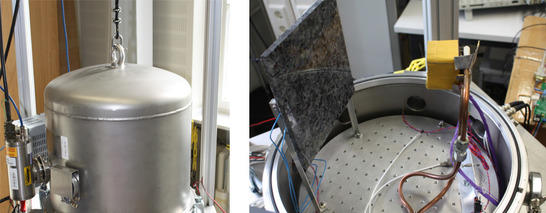Planetary X-Ray Fluorescence Spectrometer
Space Administration of the German Aerospace Centre (DLR) with means of the Federal Ministry for Economic Affairs and Energy,
Reference number: 50 JR 1303
The US Apollo- and the Russian Luna-missions returned hundreds of kilograms of surface rocks from the Moon to the Earth which have been used for detailed rock analysis. We therefore have high-precision geochemical information from very few locations on the Moon, whereas information about the rest of the Moon's surface is sparse. The main objective of developing a planetary X-ray fluorescence spectrometer (XRF) is the design of an experiment that allows us to precisely determine the geochemical composition of rocky surfaces from orbit.
 Closed vacuum chamber (left image) and open test chamber with a reference sample on the left and detector on the right side (right image)
Closed vacuum chamber (left image) and open test chamber with a reference sample on the left and detector on the right side (right image)
The first developments of a XRF laboratory prototype in the Planetary Sciences and Remote Sensing Group go back to the work connected with the Lunar Exploration Orbiter (LEO), a national concept and phase-A study of a lunar orbiter. This concept (XRF-L) has been revised several times and has also been expanded for use in the outer solar system (XRF-J).
The experiment shall be able to identify the chemical elements of a solid body without atmosphere at a distance of 50-200 km from the surface by using the highly variable solar X-ray radiation. The chemical elements of which minerals and hence rocks are formed are of special interest to geologists. These elements are, e.g., silicon, magnesium, iron, sodium, aluminum, calcium, potassium and titanium.
The development of the X-ray fluorescence spectrometer in the project team of the FU Berlin is funded by the National Space Administration with means of the Federal Ministry for Economic Affairs and Energy. The previous project was initiated under the leadership of Prof. Neukum† and led by him until March 2012. The currently granted period of eligibility is from April 2013 to September 2015 (reference number FKZ 50 JR 1303). In the ongoing project the FU Berlin co-operates with industrial partners as well as with the University of Applied Sciences Berlin (HTW) to design and construct individual components.